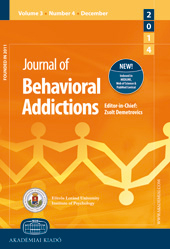Differentiation between young adult Internet addicts, smokers, and healthy controls by the interaction between impulsivity and temporal lobe thickness
Differentiation between young adult Internet addicts, smokers, and healthy controls by the interaction between impulsivity and temporal lobe thickness
Author(s): András Norbert Zsidó, Gergely Darnai, Orsolya Inhóf, Gábor PerlakiSubject(s): Behaviorism
Published by: Akadémiai Kiadó
Keywords: Barratt Impulsiveness Scale, BIS-11; cortical thickness; middle temporal cortex; problematic Internet use; smokers
Summary/Abstract: Background and aims. Internet addiction is a non-substance-related addiction disorder with progressively growing prevalence. Internet addiction, like substance-related addictions, has been linked with high impulsivity, low inhibitory control, and poor decision-making abilities. Cortical thickness measurements and trait impulsivity have been shown to have a distinct relationship in addicts compared to healthy controls. Thus, we test whether the cortical correlates of trait impulsivity are different in Internet addicts and healthy controls, using an impulsive control group (smokers). Methods. Thirty Internet addicts (15 females) and 60 age- and gender-matched controls (30 smokers, all young adults aged 19–28 years) were scanned using a 3T MRI scanner and completed the Barratt Impulsiveness Scale. Results. Internet addicts had a thinner left superior temporal cortex than controls. Impulsivity had a significant main effect on the left pars orbitalis and bilateral insula, regardless of group membership. We identified divergent relationships between trait impulsivity and thicknesses of the bilateral middle temporal, right superior temporal, left inferior temporal, and left transverse temporal cortices between Internet addicts and healthy controls. Further analysis with smokers revealed that the left middle temporal and left transverse temporal cortical thickness change might be exclusive to Internet addiction. Discussion. The effects of impulsivity, combined with a long-term exposure to some specific substance or stimuli, might result in different natures of relationships between impulsivity and brain structure when compared to healthy controls. Conclusion. These results may indicate that Internet addiction is similar to substance-related addictions, such that inefficient self-control could result in maladaptive behavior and inability to resist Internet use.
Journal: Journal of Behavioral Addictions
- Issue Year: 8/2019
- Issue No: 1
- Page Range: 35-47
- Page Count: 13
- Language: English

